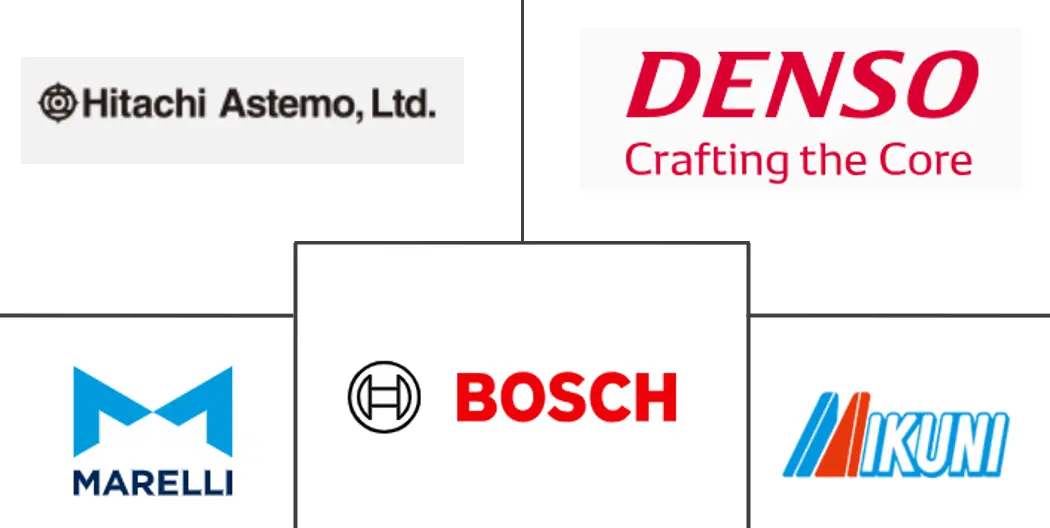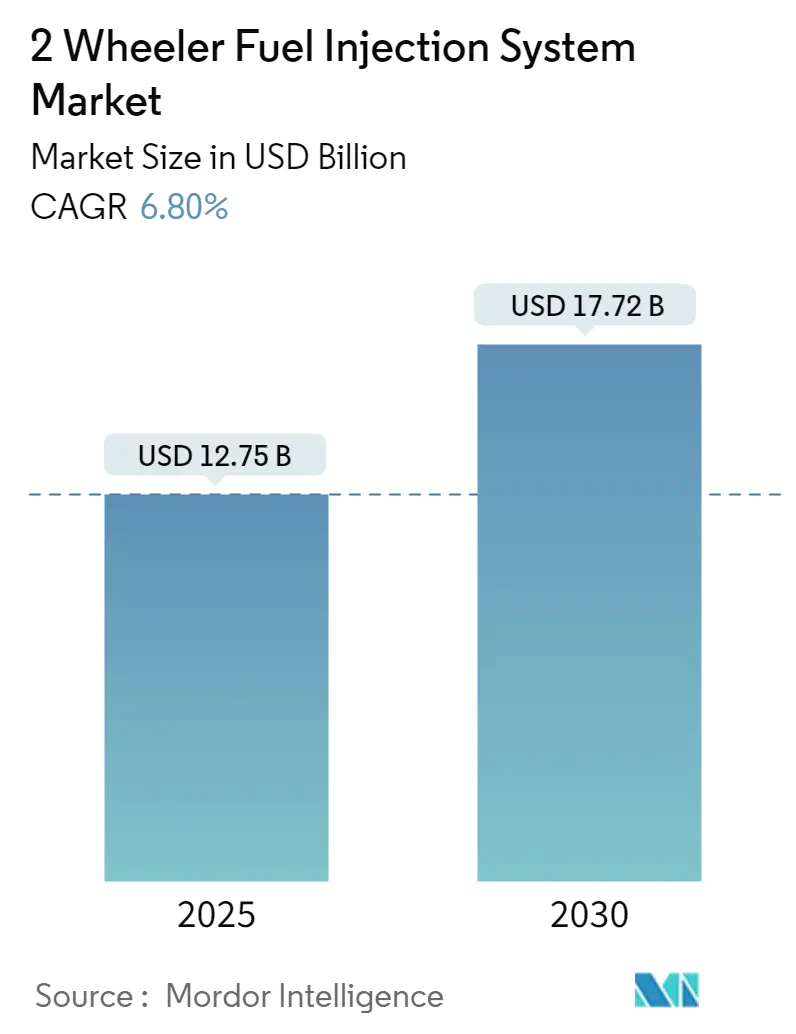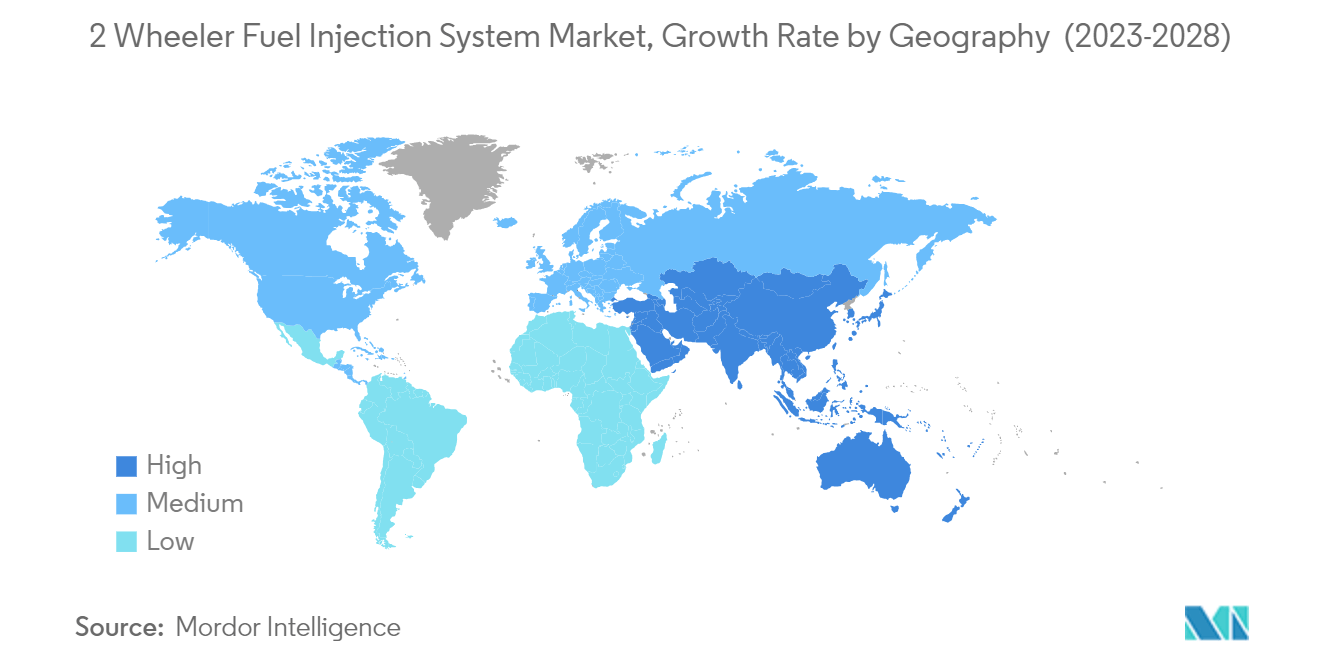Two Wheeler Fuel Injection System Market Analysis
The 2 Wheeler Fuel Injection System Market size is estimated at USD 12.75 billion in 2025, and is expected to reach USD 17.72 billion by 2030, at a CAGR of 6.8% during the forecast period (2025-2030).
Over the medium term, owing to the stringent government rules and regulations regarding two-wheeler emissions, increasing demand for cleaner and more efficient vehicles, and inefficiency of car carburetor stems are likely to drive the market.
The high number of unpaved roads and the relatively low individual buyer affordability that is observed across different households of various countries leads the buyer to opt for a two-wheeler, including a motorcycle, a moped, and a scooter. Combining the above factors creates a significant demand for two-wheeler fuel injection systems across the globe in the coming years.
The rapid adoption of Ride-by-wire (RbW) technology, as it uses actuators, sensors, and the Electronic Control Unit to throttle wire to regulate fuel and air supply in the engine, thus providing high efficiency and performance. Earlier, RbW was factory-installed only in high-end bikes. However, now it is introduced in mid-segment bikes, such as the KTM Duke 390.
Engine downsizing is on the rise as two-wheeler makers are developing smaller engines with better fuel injection systems. Downsizing shifts the engine operation to high loads where high engine efficiency exists. The lightweight engine helps to enhance fuel efficiency. The rising popularity of electric two-wheelers across the globe is likely to hinder the growth of the fuel injection system market.
Two Wheeler Fuel Injection System Market Trends
Motorcycles Dominating the Market
Motorcycles have grown significantly as a result of factors like rising urbanization, rising disposable incomes, and the need for affordable and effective transportation. Japanese motorcycle manufacturers like Honda, Yamaha, Suzuki, and Kawasaki dominate the market.
On the other hand, rising incomes, government initiatives, and the expansion of infrastructure are some of the primary reasons why people are shifting their focus away from upgrading their older motorcycles and toward purchasing entry-level passenger cars. It demonstrates that the nation is increasing its reliance on the automobile market while gradually shifting to more expensive motorcycle markets featuring larger engines (sports vehicles) and electric vehicles.
The rapid technological advancements in the automobile industry have driven (in a way, forced) the manufacturers to resort to new and upcoming vehicle tech and invest significantly into the research and development of the core design and products. While most of the manufacturers with viable resources for innovation cut, some of the manufacturers tend to stumble at the core design of the vehicles to meet market needs and resort to innovations and strategic partnerships with other players in the market.
This new wave of partnership and collaboration helps the players in the market to execute a controlled sharing of technologies and key information, leading to the overall immense benefit for the market to cater to the demand from the buyers. Consequently, the sub-Saharan region, with its relatively slow technological advancement in the automotive industry, witnessed a surge in the manufacturer partnerships between the automotive manufacturers. For instance,
In July 2022, July 2022: TVS Motor Company announced a premium model with the launch of the industry's first ‘modern-retro’ motorcycle – the TVS RONIN. Designed ground up, the TVS RONIN is a lifestyle statement that takes inspiration from the modern, new-age rider.
In May 2022, TVS Motor Company announced the introduction of limited edition TVS HLX 125 Gold and TVS HLX 150 Gold models in Kenya. According to the company, the two celebrity limited edition models were released to commemorate global sales of over two million units of the TVS HLX series.
The development mentioned above across the globe is likely to witness major growth for the market during the forecast period.
Asia-Pacific is Expected to be the Fastest Growing Region
Asia-Pacific dominates the market, and the region is expected to witness the fastest growth rate during the forecast period.
In Asia-Pacific, the Indian motorcycle market has been the largest in the world since 2016, with the presence of major manufacturers such as Hero, TVs, and Honda. With the social advancement of women and the growing demand for comfort and convenience, the demand for scooters has been continually increasing as they are convenient.
Additionally, the premium price market segment for mid and large-sized motorcycles is also expanding, owing to a growing demand for high-performance and cruiser bikes. The rapid expansion of small and medium-scale industries across the country is likely to create an opportunity for vehicle parts manufacturers.
The Rapid expansion of last-mile delivery through two-wheelers across the region is likely to witness major growth during the forecast period. Two-wheelers are easier to maneuver through traffic and narrow streets and alleys than four-wheeled vehicles, making them a significant advantage in congested urban areas. Additionally, they can be easily customized to meet specific business requirements, such as by adding delivery boxes or racks to transport goods or by modifying the seating to accommodate passengers.
Businesses can save money over time on fuel costs by using two-wheeled vehicles, which typically use less fuel than four-wheeled vehicles. Two-wheeled vehicles can sometimes move faster than four-wheeled vehicles. This is especially important for businesses that need to deliver goods quickly or provide transportation services quickly.
The expansion of two-wheeler rental and sharing services, on the other hand, is likely to witness major growth for the market during the forecast period.
Two Wheeler Fuel Injection System Industry Overview
Major players, such as Marelli Holdings Co. Ltd., Mikuni Corporation, Denso Corporation, Robert Bosch GmbH, and others, dominate the 2-wheeler fuel injection system market. Several two-wheeler manufacturers are introducing new models across the globe, which in turn is anticipated to witness major growth for the market during the forecast period. For instance, in June 2023, Adishwar Auto Ride India Pvt. Ltd. announced the localization of the two Neo-Retro rides motorcycles from the Keeway brand, i.e., SR 250 and SR 125, in the coming year. Both models are equipped with an electronic fuel injection system.
In January 2023, Yamaha Motor launched the Yamaha YZ65 in the African region. The YZ65 is powered by a liquid-cooled 65cc two-stroke engine that delivers impressive power and performance.
In March 2022, Aprilla introduced a fuel-injected two-stroke that incorporates a fuel injector above the combustion chamber, as well as a provision for injecting compressed air.
Two Wheeler Fuel Injection System Market Leaders
-
Marelli Holdings Co. Ltd.
-
Mikuni Corporation
-
Robert Bosch GmbH
-
Hitachi Astemo, Ltd.
-
Denso Corporation
- *Disclaimer: Major Players sorted in no particular order
Two Wheeler Fuel Injection System Market News
- August 2023: Honda Motorcycle & Scooter India introduced the OBD2-compliant 2023 Livo motorcycle in India. The new model is equipped with a 110cc OBD2-compliant PGM-FI engine powered by enhanced smart power (ESP). The engine consists of features such as a silent start with (an ACG) starter motor and programmed fuel injection (PGM-FI) technology with the intelligent sensor.
- July 2023: Honda Motorcycle & Scooter India launched the new Dio 125 in India. The new Dio 125 consists of a 125cc BS VI PGM-FI engine, which is equipped with a two-lid fuel opening system.
- April 2022: Suzuki Motorcycle India Pvt. Ltd. (SMIPL) launched the 250cc sports adventure tourer. The sports adventure tourer is integrated with sensors to provide data to the electronic fuel injection to monitor and deliver the ideal amount of fuel to match the riding conditions.
Two Wheeler Fuel Injection System Industry Segmentation
A fuel injection system consists of a fuel injector and a fuel pump. A fuel injection system injects fuel into the combustion chamber of an internal combustion engine using fuel injectors. An electronic control unit controls this process. The main function of a carburetor is to maintain the air-to-fuel ratio in the combustion unit.
The 2-wheeler fuel injection system market is segmented by type, vehicle type, engine displacement, sales channel, and geography. By type, the market is segmented into direct fuel injection systems and port fuel injection systems. By vehicle type, the market is segmented into scooters and motorcycles. By engine displacement, the market is segmented into less than 200 CC, 200 to 500 CC, 500 to 1000 CC, and greater than 1000 CC. By sales channel, the market is segmented into original equipment manufacturers and aftermarket. By geography, the market is segmented into North America, Europe, Asia-Pacific, South America, and the Middle East and Africa.
For each segment, the market sizing and forecast have been done based on value (USD).
| By Type | Direct Fuel Injection System | ||
| Port Fuel Injection System | |||
| By Vehicle Type | Scooters | ||
| Motorcycles | |||
| By Engine Displacement | Less than 200 cc | ||
| 200 to 500 cc | |||
| 500 to 1000 cc | |||
| Greater than 1000 cc | |||
| By Sales Channel | Original Equipment Manufacturers (OEM) | ||
| Aftermarket | |||
| By Geography | North America | United States | |
| Canada | |||
| Rest of North America | |||
| Europe | Germany | ||
| United Kingdom | |||
| France | |||
| Spain | |||
| Rest of Europe | |||
| Asia-Pacific | China | ||
| Japan | |||
| India | |||
| South Korea | |||
| Rest of Asia-Pacific | |||
| South America | Brazil | ||
| Argentina | |||
| Rest of South America | |||
| Middle-East and Africa | United Arab Emirates | ||
| Saudi Arabia | |||
| South Africa | |||
| Egypt | |||
| Rest of Middle-East and Africa | |||
Two Wheeler Fuel Injection System Market Research FAQs
How big is the 2 Wheeler Fuel Injection System Market?
The 2 Wheeler Fuel Injection System Market size is expected to reach USD 12.75 billion in 2025 and grow at a CAGR of 6.80% to reach USD 17.72 billion by 2030.
What is the current 2 Wheeler Fuel Injection System Market size?
In 2025, the 2 Wheeler Fuel Injection System Market size is expected to reach USD 12.75 billion.
Who are the key players in 2 Wheeler Fuel Injection System Market?
Marelli Holdings Co. Ltd., Mikuni Corporation, Robert Bosch GmbH, Hitachi Astemo, Ltd. and Denso Corporation are the major companies operating in the 2 Wheeler Fuel Injection System Market.
Which is the fastest growing region in 2 Wheeler Fuel Injection System Market?
Asia-Pacific is estimated to grow at the highest CAGR over the forecast period (2025-2030).
Which region has the biggest share in 2 Wheeler Fuel Injection System Market?
In 2025, the Asia-Pacific accounts for the largest market share in 2 Wheeler Fuel Injection System Market.
What years does this 2 Wheeler Fuel Injection System Market cover, and what was the market size in 2024?
In 2024, the 2 Wheeler Fuel Injection System Market size was estimated at USD 11.88 billion. The report covers the 2 Wheeler Fuel Injection System Market historical market size for years: 2019, 2020, 2021, 2022, 2023 and 2024. The report also forecasts the 2 Wheeler Fuel Injection System Market size for years: 2025, 2026, 2027, 2028, 2029 and 2030.
Our Best Selling Reports
Two Wheeler Fuel Injection System Industry Report
Statistics for the 2025 2 Wheeler Fuel Injection System market share, size and revenue growth rate, created by Mordor Intelligence™ Industry Reports. 2 Wheeler Fuel Injection System analysis includes a market forecast outlook for 2025 to 2030 and historical overview. Get a sample of this industry analysis as a free report PDF download.







